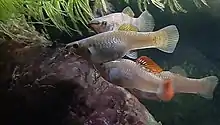| Liberty molly | |
|---|---|
 | |
| Scientific classification | |
| Domain: | Eukaryota |
| Kingdom: | Animalia |
| Phylum: | Chordata |
| Class: | Actinopterygii |
| Order: | Cyprinodontiformes |
| Family: | Poeciliidae |
| Genus: | Poecilia |
| Species: | P. salvatoris |
| Binomial name | |
| Poecilia salvatoris Regan, 1907 | |
The liberty molly (Poecilia salvatoris) is a fish species from El Salvador.[1] It is one of the short fin molly species in the Poecilia sphenops complex, and had been often regarded as synonymous with P. sphenops until recently.[2][3][4]
Males and females are colored similarly, but the males' coloration is stronger.[3] The body is silvery but speckled with blue and orange.[3] The fins contain black and blue as well as either red or yellow.[3] The red color version is probably the source for the common name "liberty molly" as a result of the combination of red, white and blue colors.[3] Maximum length is about 3 inches (7.6 cm), with females generally larger than males.[3]
According to Dr. William T. Innes, who regarded the species as color variety of P. sphenops, the liberty molly was first imported for the aquarium hobby in 1935.[5] In the aquarium, the liberty molly can be aggressive towards other tankmates and nip the fins of other fishes in the tank.[3][5] According to Innes, this aggressiveness and the loss of color intensity over captive generations led to the fish losing popularity in the hobby.[5] Males in particular are aggressive towards each other.[3] Tropical Fish Hobbyist recommends keeping the liberty molly in a species tank, in a ratio of at least two females per male, stating that three males and six females would be suitable in a 30-gallon aquarium.[3] The liberty molly is prone to jumping, and so the tank should be covered.[3][5] It needs vegetable matter in its diet.[3]
References
- ↑ Froese, Rainer; Pauly, Daniel (eds.) (2019). "Poecilia salvatoris" in FishBase. August 2019 version.
- ↑ Freshwater and Marine Aquarium. 24 (10–12): 188.
{{cite journal}}: Missing or empty|title=(help) - 1 2 3 4 5 6 7 8 9 10 11 Monks, N. (August 2011). "7 Forgotten Livebearers". Tropical Fish Hobbyist. Retrieved 2013-03-10.
- ↑ Bailey, M.; Sandford, G (1999). Aquarium Fish Identifier. Lorenz Books. p. 52. ISBN 9780754800101.
- 1 2 3 4 Innes, W. (1966). Exotic Aquarium Fishes (19th ed.). Metaframe. pp. 362, 574.